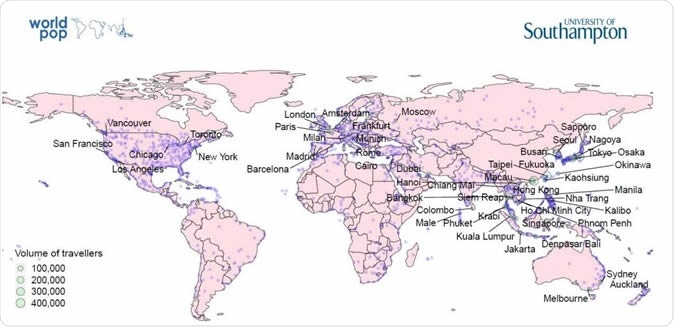The Wuhan coronavirus or 2019-N-CoV has spread across the globe, including Australia, United States, Cambodia, Canada, France, Germany, Japan, Malaysia, Nepal, Singapore, South Korea, Sri Lanka, Taiwan, Thailand, and Vietnam.

Image Credit: remotevfx.com / Shutterstock
Now, Academics at the University of Southampton released a new report on the 20 cities at the highest risk of the novel coronavirus spread. They used travel data to determine which cities are more likely to see cases in the future.

Geographic distribution of cities across the globe receiving airline travellers from 18 high-risk cities (Figure 6) in mainland China over a period of three months, representing 15 days before Lunar New Year’s Day and 2 and half months following Lunar New Year’s Day. The volume of airline travellers of the top 30 ranked cities is presented.
Bangkok, Thailand tops the list, making it at the greatest threat of the potentially fatal infection, spreading from China. Meanwhile, cities like Hong Kong, Taipei, Seoul, Tokyo, and Singapore came in next. Included in the world risk map list are Phuket, Osaka, Kuala Lumpur, Macau, Denpasar Bali, Sydney, Chiang Mai, Melbourne, Los Angeles, New York, Dubai, Niha Trang, London, and Ho Chi Minh City.
Though millions of people have been contained to mitigate the spread of the deadly virus, Chinese authorities report that at least five million people were projected to have left the province of Hubei, where Wuhan is located, for the Lunar New Year holidays before travel bans were imposed.
The countries at the highest risk due to travel of Chinese residents include Thailand, Japan, Hong Kong, Taiwan, South Korea, the United States, and Malaysia. Other countries include Singapore, Vietnam, Australia, Indonesia, Cambodian, Macao, China, Philippines, Germany, Canada, United Kingdom, United Arab Emirates, Italy, and Russia.
The new world risk map report comes as foreigners and tourists trapped in Wuhan are waiting to be rescued. Residents and tourists stranded in the city are asking for help, with food and water supply running out and communication methods revolve only around SMS and social media platforms.
Latest cases and death toll
The deadly and contagious virus has infected 5,974 people as of writing, with the death toll topping 132, surpassing the infection record of Severe Acute Respiratory Syndrome (SARS) that affected the same country in 2002 to 2003.
SARS infected 5,327 people within nine months and has killed 349 people across the globe, a majority of which occurred in China, according to the World Health Organization (WHO).
In Hubei province, where the infection first emerged, there were an additional 840 newly confirmed cases and 25 deaths in just a matter of days. An estimated 3,300 people are still hospitalized in the province, while more than 20,000 are under observation for infection.
The number of cases is continuously increasing while most of the fatalities were patients who are more than 60 years old and those who have preexisting health conditions. The Wuhan coronavirus, which causes pneumonia-like symptoms is more potent in overwhelming people with compromised immune systems, such as those with HIV, AIDS, older people, pregnant women, infants, children, and those with other health conditions.
New developments
Airports across the globe expanded screenings for potential carriers of the coronavirus. However, Chinese health experts have warned that the virus can spread even during the incubation period, a period where there are no noticeable symptoms. This would make screening and controlling the virus spread more difficult.
In the United States, strict screening of passengers has been imposed in 20 airports. Federal health officials claim they’re accelerating efforts to find vaccines and treatment procedures to stem the spread of the virus. However, it will take months for a vaccine to be developed for human use since it will go through tedious processes of clinical trials.
The Wuhan coronavirus has still no approved vaccine or cure. The only action doctors can provide at this time is relieving, treating symptoms and preventing complications.